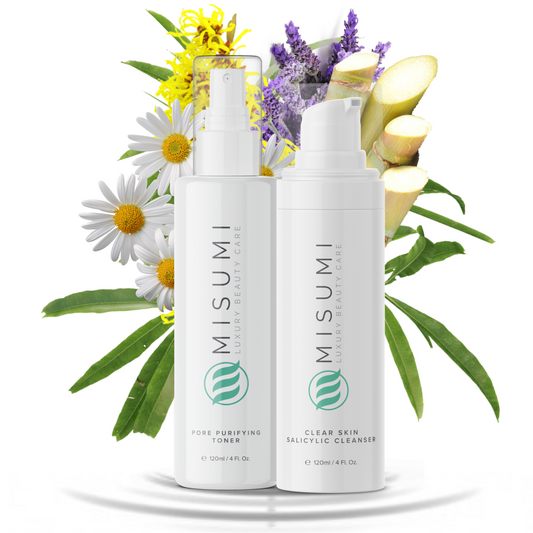When it comes to face oils, there is a right way to incorporate them in your skincare routine without causing any issues on your skin. By doing so, you will be reaping all the benefits face oils have to offer, and then some. If you don’t know where to start with face oils, which face oils to use or how to use them, then you’re in the right place.
A person’s skincare routine can consist of as little as three steps, but it can also consist of ten different steps. If yours falls under the latter, then adding a new product can be a little bit challenging. Where does it go? How long do I have to wait before I move on to the next product? Do I have to use it every day?
If these questions arise in your mind regarding face oils, don’t worry. We have all the answers.
The Benefits of Using Face Oils for Your Skin
First and foremost, before explaining all the ways you can use face oils in your skincare routine, let’s see which benefits you can get from using them.
Face Oils Contain Omega Fatty Acids
One of the most important ingredients of facial oils are omega fatty acids, especially omega-3 fatty acids. These are not only great for us when ingested, but they also provide many benefits if they’re applied topically on the skin.
Omega-3 fatty acids are known to lower inflammation, which is one of the culprits for problems with the skin such as acne or eczema.
So, which oils contain omega-3 fatty acids? Rosehip oil is one of the most potent sources of omega-3 fatty acids. Luckily for us, it’s also non-comedogenic, meaning it’s perfectly safe to apply it topically on the skin.

If you want a face oil that contains omega-6 fatty acids, look no further! Both avocado oil and grapeseed oil are amazing sources of omega-3 fatty acids, which are also known to be anti-inflammatory and protect the skin’s barrier.
Some oils might be infused with omega fatty acids, so make sure you always check the ingredients list.
Face Oils Can Protect the Skin
Face oils can successfully protect the outermost layer of skin, which will keep all the environmental pollutants out, along with any other bacteria. Think of them as an extra coating for your face that will keep all the gunk out.
There are many risks that can come with any damage to our skin’s barrier function, such as dull-looking skin, poor texture and sensitive skin that’s more prone to inflammation and chronic conditions.
Face oils will protect you from all of these, and give your skin more nutrients in the process. Talk about multitasking.
Facial Oils Contain Crucial Antioxidants
Antioxidants do wonders for our skin (and body) in many different ways. By choosing the right oil that agrees with your skin type, you will be providing your skin with free radical fighting antioxidants, which will result in glowing and healthy skin in the long run.

A prolonged exposure to free radicals can result in hyperpigmentation and uneven skin tone. Antioxidants can help revitalize your skin and brighten your skin tone, as well as reduce irritation and signs of aging.
Not only can you apply them topically on your skin, but you can also consume antioxidant-rich food for double the benefits!
How to Use Facial Oils In Your Skincare Routine
Now you know what benefits you can get from adding a facial oil in your skincare, but how do you actually incorporate it along with all your other products?
Here are all the ways you can add facial oils in your skincare routine for maximizing its benefits.
Facial Oils on their Own

The easiest way to incorporate facial oils in your skincare regimen is by using them in isolation, before or after you’ve applied your moisturizer. The timing depends on which skin oil you decide to go for. If you opt for an oil that is fast-absorbing, then feel free to apply it before you apply your moisturizer. If the oil you’ve chosen needs more time to sink into the skin, then you can apply it after you’ve applied a layer of your favorite moisturizer.
Facial Oils Can Be Combined in Moisturizers and Serums
Another easy way to get into the world of facial oils is by combining them with products you already use and love, such as your moisturizer or serum. Mixing a couple of drops of facial oil in your favorite moisturizer or serum will enable you to experience all the benefits the oil has to offer without wasting much time waiting for the oil to absorb into the skin. It’s also an easy way to get your skin used to the oil because you won’t be putting it directly on your skin.
If you don’t like the feeling of oil sitting on top of your skin, or you’re a bit hesitant as to how your skin will react to the oil, then the best course of action is to combine it with one product your skin is already used to. By mixing facial oil with these products, you will enhance all the benefits of the oil.
Facial Oils Mixed In with Foundations

A great way to save some time in the morning and provide your skin with the hydration it deserves is by mixing a few drops of oil in your favorite foundation. This will not only make your foundation look dewy instead of cakey, but it will also apply more smoothly. And the best part is that you will save some time in the morning, and all of us could use a little extra time to get ready.
How to Apply Facial Oils On Your Skin
Now for the most important part: how to actually apply the facial oil on your skin. You already know how to use moisturizers and serums, but if you’ve decided to use the oil in isolation, you might need some guidance.
One crucial difference between applying face oils and moisturizers is which motions you use, as well as the amount of pressure that’s applied. Don’t rub oils vigorously on the skin. Instead, pat or dab them gently on the skin in order to ensure that you’re making the most of them.
Another important note is that you shouldn’t use more than a couple of drops at a time. Remember, face oils are potent sources of nutrients, so more product doesn’t necessarily equal a better outcome. Adding more product on the skin won’t mean that your skin is absorbing more nutrients. Instead, you’ll just be wasting money while doing it. So, a couple of drops is all you need, and this amount will cover your entire face and neck.
How to Find the Best Facial Oil for Your Skin Type

You’ve mastered all the techniques you need to know before you go out and purchase a facial oil, and now it’s time to delve into how to actually select the facial oil that will be useful for your particular skin type.
Choosing products based on your skin type is the safest way to avoid wasting your money and time. After all, if you continue to use the wrong products, how can you expect to see any results?
Here is how to select the right facial oil for your particular skin type.
Facial Oils for Oily Skin
It’s a common myth that adding facial oils on oily skin will increase the amount of sebum which the skin is producing. This claim couldn’t be further from the truth. If you pick the right oil for oily skin, it will balance the amount of sebum your skin is producing, resulting in a less shiny appearance and less acne in the long run. Adding a non-comedogenic oil that’s appropriate for oily skin is one of the best things you can in order to minimize oil production and decrease the size of your pores.
The only thing you need to remember is that oils aren’t a substitute for a good moisturizer. If you’re planning on layering a facial oil and a moisturizer on top of each other, make sure that the moisturizer itself doesn’t contain any oil, since it might be too much for your oily skin to handle. Other than that, you shouldn’t experience any side-effects.
The best oils to use if you have oily skin are jojoba oil, tea tree oil and macadamia oil.
Facial Oils for Dry Skin

If you have dry skin, you’re in the right place. Facial oils are extremely hydrating, and by using them on a regular basis you will be doing your skin a favor. By adding them in your everyday skincare routine, you will be hydrating your skin, smoothing any imperfections and minimizing the appearance of fine lines and wrinkles. People who have dry skin are more prone to getting premature signs of aging, so using a face oil is an all-round remedy. In addition to using facial oils, make sure you don’t forget to moisturize.
For dry skin types, protecting the skin barrier is crucial in the quest for healthy skin. Luckily, since you have dry skin, your skin won’t be as picky, so you can use heavier face oils. The best facial oils you can use for dry skin include argan oil, jojoba oil and coconut oil.
Facial Oils for Sensitive Skin
If you have sensitive skin, you might be hesitant to try something like facial oil. And we get it, it seems quite risky at first. However, it’s not that scary, assuming you have all the knowledge about how to use it correctly.
As we’ve mentioned before, facial oils are a very potent source of antioxidants. Those antioxidants can do wonders for people who have sensitive skin, as well as those who have damaged skin due to inadequate treatment or using the wrong products for a prolonged period of time.

On top of that, facial oils have anti-inflammatory properties, which definitely can be of help to those who have sensitive skin. If this is you, then you need to pay extra attention to the kinds of oils you use. The most important thing to remember is that you need to make sure that the oil of your choice is labeled as non-comedogenic, meaning it won’t likely block your pores and cause you to break out. Other than that, aim for facial oils which are specifically designed for people who have sensitive skin. That way, the chances of you suffering from any unwanted side-effects will be minimized.
The best oils to use for sensitive skin include argan oil and tea tree oil.
Aging Skin
While we can’t do much about the aging process itself, there are some steps we can take in order to keep the side-effects of aging at bay. One of these steps is using good quality facial oils as part of our skincare routine.
As we age, the amount of oil which our skin produces is reduced, meaning that the older we get the drier skin we have. And while this might be good news for people who have extremely oily skin, the rest of us need to think of ways to retain all the moisture we can so that our skin doesn’t over dry. Dry skin tends to bring out the wrinkles and fine lines on our face, so we need to think of ways to hydrate our skin so that it stays like that in the long run. Luckily for us, we have facial oils at our disposal.
Facial oils can actually reduce the appearance of wrinkles not only due to the hydration they provide, but also thanks to the antioxidants they contain. Antioxidants are responsible for providing ample amounts of collagen and keeping the skin plump and youthful. Since most facial oils contain antioxidants, any one you choose will be of help if you struggle with aging skin. However, argan, rosehip and grapeseed oils are a good place to start.
Will Facial Oils Break Me Out?
One of the most common concerns people have regarding facial oils is that they might break them out. Although facial oils can be tricky to incorporate into your skincare routine, and although some people might have had a bad experience with them, it doesn’t mean that you will have the same experience.

Choosing the right oil for your skin is crucial if you want to avoid any breakouts, congestion or irritation. Naturally derived oils won’t break you out, assuming you use them properly and you use the right amount of the product. In fact, the opposite is true. All their anti-inflammatory properties, along with the amount of antioxidants they contain, will help you in your battle against acne.
What you do want to stay away from, especially if you have sensitive, acne-prone skin, is mineral and synthetic oils. You’ve probably read these on one of your labels and wondered whether they might affect your skin negatively. The truth is that many people don’t tolerate mineral and synthetic oils on their skin, and you might be one of them. So, if your skin is on the problematic side, it’s best to avoid products which contain them.
Facial Oils Aren’t a Substitute for Sunscreen!
Sometimes, people use facial oils as a substitute for sunscreen. Some people claim that it has the same effect as SPF. And while it’s true that some facial oils can protect your skin from the sun to a small extent, they don’t have the same properties as regular SPF. Facial oils don’t protect your skin from damaging UV light, and their effect is very short-lived.
You should always apply sunscreen after you’ve applied the facial oil of your choice. Make sure you use at least SPF 50 for your face and reapply it regularly throughout the day.
Takeaway
It seems like facial oils have a bad rep due to the myths which are oftentimes spread about the effects of using them in your skincare routine. And although you might know someone who has had a bad experience with some type of oil, it doesn’t mean that you will also have a bad experience trying them out for yourself.
Keep in mind that not all facial oils are created equal. When selecting the kind of oil you’ll put on your skin, look for one that’s designed for your specific skin type, as well as one that contains the label ‘non-comedogenic’ on the packaging. Remember to do a patch test before putting the oil all over your face in order to avoid any irritation or breakouts.
This information is meant to supplement, not replace advice from your doctor or healthcare provider and is not meant to cover all possible uses, precautions, interactions or adverse effects. This information may not fit your specific health circumstances, and its goal is to offer a general view of the subject. In case you are suffering from a severe case of acne, you should consult with a dermatologist or a certified medical professional.







